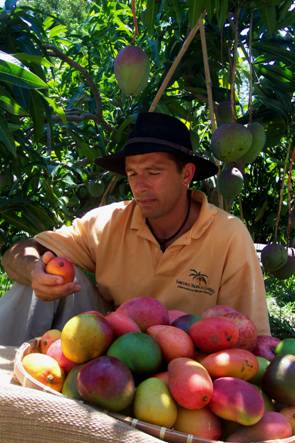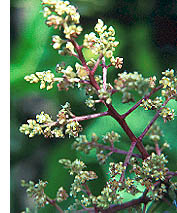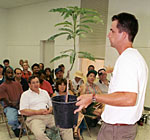
The Mango: How to Grow, Care For and Enjoy “The King of Fruit”


South Florida has the largest population of mango trees per capita in the United States and the numbers continue to grow. Mango trees are an indispensable part of South Florida’s landscape, giving homes, commercial sites and parks a sense of beauty and tranquility and, of course, delicious fruit to enjoy during the mango’s long fruiting season.
There are several things to consider when growing mango trees. Dr. Richard J. Campbell, Senior Curator of Tropical Fruit at Fairchild Tropical Botanic Garden and world expert on mangos suggests, “keep it simple.” This philosophy has proven very successful at Fairchild, which has the world’s largest mango collection. “Mango trees grow well in South Florida, so all you have to do is figure out what mango fruit you want to enjoy, have ground space of about 6 feet, good water and mulch.” These tips round up Campbell’s keep it simple approach.
Mango experts, like Campbell and his father Dr. Carl L. Campbell, Ph.D., also recommend selecting trees that produce fruit that aren’t readily available in supermarkets. “Mango cultivars like Tommy Atkins or Kent are widely available at most supermarkets. Mangos, like the Nam Doc Mai, Julie, or Edward are higher quality mangos and can be grown easily in your backyard yet can’t always be found in the produce section” adds the senior Campbell.

Here are some more planting tips to consider:
- Location — the mango tree grows to a good size and casts a dense shade, but the roots are not destructive.
- Planting — any time of the year is good, provided the weather is warm and the trees are not in active growth.
- Soil — Mangos will grow in almost any well-drained soil whether sandy, loam or clay but avoid heavy wet soils.
- Planting — Cut the container that the tree is in for easy removal and make the hole two to three times as wide as the container. Make the hole no deeper than the height of the root ball. Gently place the tree straight in the hole and fill around the ball with soil, gently firming it. Water thoroughly while planting to remove any air pockets. Mulch with a 2 - 3 inch layer of organic material to buffer soil temperature, conserve moisture and reduce weed competition.
- Watering — If rainfall is less than 25 mm (1 inch) per week following planting, then the tree should be watered every 3 to 4 days for the first 4 months of initial establishment.
